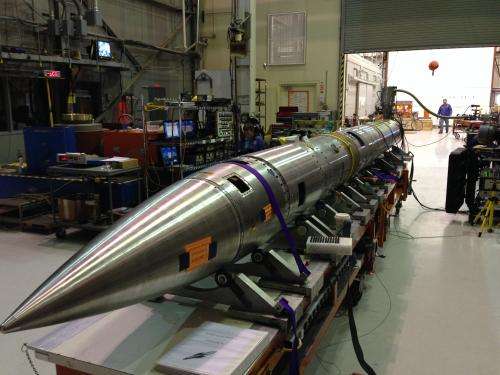CHESS rocket to study birthplace of stars

Update - May 27, 2014: NASA successfully launched the Colorado High-resolution Echelle Stellar Spectrograph, or CHESS, payload aboard a Black Brant IX suborbital sounding rocket at 3:35 a.m. EDT on May 24, 2014, from the White Sands Missile Range in New Mexico. Principal investigator Kevin France at the University of Colorado at Boulder reports that good data was received and the mission was a success. Recovery of the payload is in progress, as planned.
In deep space, floating between the stars, lies an abundance of atoms—carbon, oxygen, hydrogen—that over millions of years will grow into new stars and new planets. Early in the morning on May 24, 2014, at 2 a.m. EDT, a NASA Black Brant IX sounding rocket will carry a payload for a 15–minute flight to observe this star nursery more comprehensively and in better detail than has been done by a single instrument ever before.
"These atoms are the raw materials, the very building blocks for the next generation of stars and planets," said Kevin France at the University of Colorado at Boulder. "We're making detailed measurements of how many atoms have transitioned into molecules, which is the very first step toward star formation."
The sounding rocket payload, Colorado High-resolution Echelle Stellar Spectrograph or CHESS, will launch from White Sands Missile Range in New Mexico. CHESS is equipped with what's known as a spectrograph, which can parse out just how much of any given wavelength of light is present. CHESS will soar above Earth's atmosphere to look at the ultraviolet light from a bright star – light that is blocked by the atmosphere and can't be seen from the ground. As this light courses toward Earth, it bumps into the interstellar atoms and molecules along the way, each of which can block certain wavelengths of light. Scientists know which wavelength is blocked by what, so by measuring what light is missing, they can map out the atoms and molecules that are present in space.
The CHESS spectrograph provides such detailed and comprehensive observations that it can measure not only what atoms and molecules are present, but how fast they are moving and how turbulent the gas is. Together, this information helps characterize how mature a given cloud of dust is.
"Carbon, for example, will appear differently over time," said France. "Early on the cloud will have carbon with a missing electron, called ionized carbon. As the gas gets denser, the carbon atoms gain back their electrons, so you have neutral carbon. As you get even denser clouds, the carbon binds to oxygen creating carbon monoxide molecules – and at that point you can probe the cloud conditions that precede the collapse into a star."
Using something like CHESS to see whether you have ionized or neutral carbon, or even carbon monoxide molecules tells you more about how old the cloud is and can help scientists learn how stars form from these clouds. It's still not known exactly how long it takes before a cloud collapses to begin making a star, for example. It might be anywhere between 1 to 100 million years.
By flying such newly-developed instruments on a relatively inexpensive sounding rocket, scientists do more than just gather solid science data. They also have the chance to test and improve their instruments, perhaps to someday fly long-term on a satellite in space.
NASA successfully launched the Colorado High-resolution Echelle Stellar Spectrograph, or CHESS, payload aboard a Black Brant IX suborbital sounding rocket at 3:35 a.m. EDT on May 24, 2014, from the White Sands Missile Range in New Mexico. Principal investigator Kevin France at the University of Colorado at Boulder reports that good data was received and the mission was a success. Recovery of the payload is in progress, as planned.
Provided by NASA





















